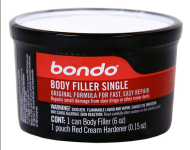So, my apologies if this is a necro (thread is less than a month old, but I don't know the local standards) but as an old modeller who's used all off the materials mentioned above, I hope I can provide a comparison:
My most recommend would be the hardware store steel-impregnated epoxy putty. It will have the best balance of strength, adhesion, and toolabilty. It's the only one I might use without putting a permanent backing over the hole (like a piece of brass sheet) for reinforcement.
Procedure would be to place masking tape across the back of the hole, mix a small amount of putty and pack it into the hole. Use something rigid like a bit of card or something to brace the back of the tape while packing. It can be smoothed using water or isopropyl and any flat, smooth tool without crowned or burred edges (a popsicle stick will work, but something like the back of a polished knife will work better, as long as it has a straight edge). With careful smoothing, you can minimize or even eliminate the need for sanding to get a flush surface.
The epoxy won't bond well to the tape adhesive, so once it's cured, you can peel the tape off the back quite cleanly. Tool and surface cleanup can be done with isopropyl.
Ideally wear gloves when handling any expoxies or epoxy putties. They are not usually irritants, but they are allergy sensitizers.
JB Weld is the best metal-to-metal adhesive I've personally used, and can be used as a toolable putty if you do it right. However, it will be brittle in this sort of application (flat, thin, and freestanding) unless you use a permanent backing. It also has a very long setting and curing time (~4 hours), and that discourages casual use. There is a 5-minute version, but in my experience it's rubbish compared to the regular version, so I don't recommend it at all.
Procedure would be the same as with epoxy putty, but you''ll want to use some JB Weld to glue the brass sheet across the back of the hole before taping it down and filling in the front. Leave it for ~2 hours to partially cure, and you'll be able to smooth it with water almost like an epoxy putty before it finishes curing.
Combining steel epoxy putty with a JB welded brass or aluminum sheet backing will give you the most secure and load bearing results out of all the materials/methods mentioned.
Bondo's main advantages are that it's cheap by volume, and it mixes very quickly and easily. Downsides are it's messy AF, has the least aggressive adhesion relative to the other options mentioned, shrinks as it cures, is not truly thixotropic, and absolutely no-negotiation requires full ventilation and gloves to work with. It is toxic and VERY fumey. I would avoid it in small application uses like this unless you're already experienced with it. Generally speaking, it works best in larger applications, and if you can afford epoxy putty you should use that instead, in literally any use case IMO. Epoxy putty adheres better, is WAY more controllable, way more dimensionally stable, and tools/sands better.
Clear "liquid" epoxy varies a lot between manufacturers, but generally I wouldn't recommend it unless you need/want pourabilty or transparency. It adheres better than bondo, but not as well as JB Weld. It will have great initial lack of brittleness, but will often become more brittle as it ages (just a few years). Toolability is about on par with bondo, and it generally shrinks less than bondo, but more than putty or JB Weld.
Stuff to avoid (not mentioned by others, but I feel I must head it off, as you're likely to see it mentioned elsewhere):
"Green Stuff" AKA Kneadatite epoxy putty. This is popular among gaming mini modelers, but it's unsuited to the job discussed here. It has chewing gum like consistency when soft, so it's harder to apply precisely and to smooth/feather when soft. It cures to a hard rubber consistency, so it doesn't take tooling or sanding well. It adheres about as well as bondo.
Other modelling/sculpting epoxy putties like Milliput, Aves, or MagicSculpt. These will be usable, and will work about as well as the plastic/wood repair harware store epoxy putties, but won't be as durable/load bearing as the steel type (roughly in the same class as bondo durabilty-wise, though better in almost every other way except cost).
CA glue/Superglue and baking soda. This is fast and easy, but fumey, messy, brittle when fully hardened, and remains chemically reactive forever due to the baking soda. Using talc insted of baking soda makes it less brittle and non-reactive when hardened, but it's still not good enough, and still messy.



